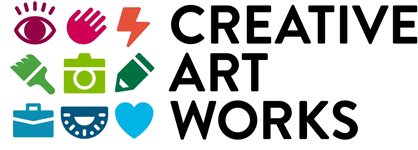Unmasking Creativity: PS 278 Students Bring Carnival to Life
A student at PS 278 displays her Carnival Mask in progress.
Even students who did not initially consider themselves to be artists felt inspired by the magic of the project and were happy to participate fully.
Making art is a way for young minds to explore, express, and connect with the world around them. And what better day to reminisce on one of our recent youth art making programs than today—the end of Carnival. Also known as Mardi Gras or Fat Tuesday, these celebrations are famous around the world for masked revelers and spirited festivities. So, we thought that this Fat Tuesday would be a great time to celebrate some of our young artists who created fanciful and fun masks as part of an after-school mixed-media art “Power-Up” program at PS 278 in Upper Manhattan.
Students began by looking at samples of masks from around the world and learning the historical and cultural significance of them. Students examined function in ancient cultures: Ancient Egypt for rituals, Classical Greece for theater, and African and Indigenous cultures for connection with spirits and symbolization of status.
In the Americas, Carnival is deeply rooted in Afro-Indigenous resilience and cultural expression. While Carnaval still somewhat aligns with the Christian calendar (leading up to Lent) its traditions carry the legacy of African and Indigenous peoples through masking, music, costumes, and dance.
In many cultures, masks allow people to transform into fantastical versions of themselves, honor cultural symbols, or simply embrace the joy of the festivities. CAW Teaching Artist Emma Smoluchowski prompted students to think about what they wanted their mask to express. How would they use their mask in a festival? What powers would such accessories lend to the person who wears it? What do masks say about who we are or how we want to be seen?
“Through this project, students connected with global traditions while making masks that reflect their own identities, creativity, and voices. They loved the process of creating an armature for their masks, getting messy with the papier mâché, and then painting!”
Students enjoyed the process of creating their masks and getting messy with the papier mâché.
Making the Masks: Students began sketching their own unique designs on paper. They were eager to share their designs with their classmates and lively discussions ensued.
Each student was given a blank plastic mask to serve as the armature for their own creation. Then, using a variety of materials, including cardboard, masking tape, and newspaper, they added additional features and detail to their faces. Next, they began layering papier-mâché over the entire mask, to give it a cohesive look. Finally, they painted their masks with more details and bold colors, allowing their vision to come to life as tools for transformation and personal expression.
So… what’s up with all the horns? Devils play an important role in many Carnival celebrations. Students in the Power Up! class particularly loved "Los Pepines," Carnival characters from the city of Santiago in the Dominican Republic. Los Pepines are a distinct subgroup of “Los Lechones,” masked characters who clear the streets so the parade can move through the crowds. While the Los Lechones are guardians of order, In Trinidad, they have the mischievious "Jab Molassie," which translates to "Molasses Devils." These characters originated in colonial times as a way for slaves to mock their overlords. Today, the Jab Molassie attempt to scare, or play tricks on, other revelers unless they are offered gifts.
The Big Celebration: For many students, the moment of showing off their handmade masks was one of pure pride. This took place at a gallery walk open to the entire school community in which students acted as docents to their own work and that of their peers. Providing access to artmaking for students is one of the pillars of CAW. As they are able to express their creativity, enjoy sanctioned messiness, and make art they can be proud of, students interact with the traditions of other cultures in an accessible, engaging way.
Many students were inspired by “Los Pepines,” devil characters who act as crowd control during parades.
At a gallery walk at the end of the Power Up! program, students proudly presented their art, including their masks, to the entire school.
Power Up! is a program funded through the NYC Council’s Cultural After-School Adventures (CASA) Initiative, which brings high-quality arts partnerships to New York City public schools, particularly in underserved communities. There are many ancillary benefits to CASA programs, including measurable increases in engagement, graduation rates, and school attendance. In fact, 91% of students in the Power Up! class reported that they were more excited to attend school on the days that they had the Power Up! program after class.
Here's to our young artists at PS 278— may they continue to power up their creativity and embrace the magic of artistic expression! Happy Mardi Gras to all!
This Creative Art Works program is supported, in part, by the New York City Department of Cultural Affairs and the Cultural After-School Adventures (CASA) Initiative in partnership with the NYC Council and Council Member Shaun Abreu. This Creative Art Works program is also made possible by the New York State Council on the Arts with the support of the Office of the Governor and the New York State Legislature.











